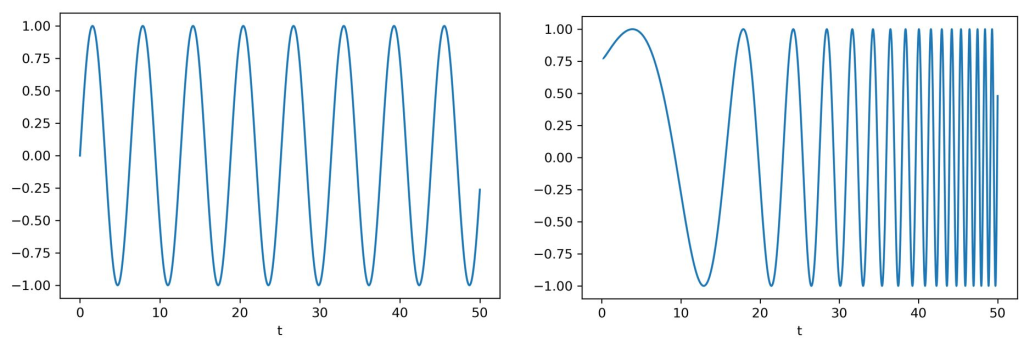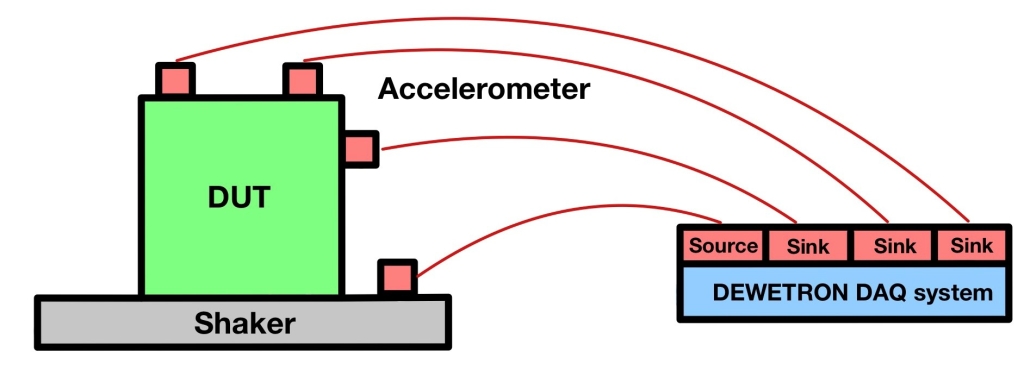Swept sine analysis

Whether it is indoor noise or the vibration of a vehicle on the road: Vibrations and oscillations are everywhere in nature and engineering. This is exactly why engineers need an effective and simple tool to analyze such vibrations and especially their effect on objects. A very popular method is the swept sine analysis (or sine sweep analysis). In this blog post we will tell you more about swept sine analysis and where you can use it.
What is a sine sweep?
The simplest type of oscillation one can think of is a harmonic, sinusoidal oscillation. Even if pure sinusoidal oscillations rarely occur in nature, one can gain a lot of knowledge from their analysis.
Each sinusoidal oscillation has a frequency, which indicates how fast the oscillation proceeds. A practical example is a sound wave: We perceive sound waves with high frequency as high tones, sound waves with low frequency as deep tones.
In a swept sine analysis, one applies a sinusodial oscillation on a system (e.g. a mechanical component). However, the frequency of the oscillation is not kept constant, but is continuously increased from a minimum value (such as 1 Hz) to a maximum value (for example 20 kHz). You can see a sine sweep in the following figure.

Sine signal (left) and sine sweep (right)
This transition from minimum to maximum frequency is a sine sweep. Often, one performes several such sine sweeps in succession to increase the measurement accuracy.
What is a sine sweep good for?
In practice, it is often the case that components react sensitively to certain frequencies. This becomes obvious when looking at a swing: If you push a swing with the right frequency, the swing will oscillate higher and higher. But if you push the swing with the wrong frequency, the swing will barely oscillate or even slow down. This phenomenon, called resonance, also occurs in mechanical components. Resonance can cause damage or destruction of individual components in cars or other devices, creating a safety hazard. Therefore, one has to avoid resonances at all costs.
The swept sine analysis is a simple method to test for resonances. In a swept sine analysis, you excite the system you want to test with a sinusoidal signal. However, because a sine sweep passes through many different frequencies continuously, a more effective detection of resonances is possible. This makes a swept sine analysis an important tool for structural analysis as well as stress testing.
Another important application of swept sine analysis is in audio engineering. For example, a sine sweep can be used to test the sound insulation of buildings with respect to high and low tones. Swept sine analysis is also used to improve room acoustics. In such a case, one measures the echo of the sine sweep with several sensors placed in the room and therefrom calculates other acoustic values such as reverberation time or clarity.
What do you need to perform a swept sine analysis?
A swept sine analysis is not only easy to explain, but also easy to perform. In audio engineering, all you need is a loudspeaker to send out the swept sine signal and microphones to pick up the resulting reverb.
For mechanical analysis, it requires a bit more equipment. You can see the layout of such a measurement setup in the graphic below.

Measurement setup for a swept sine analysis
A DUT (device under test) is excited by a vibrating shaker. Usually, one attaches acceleration sensors (so-called accelerometers) to the DUT and the shaker. These sensors are in turn connected to a measuring device, such as our DEWETRON DAQ systems. The accelerometer attached to the shaker provides the excitation or input signal. The accelerometers attached to the DUT measure the response of the DUT to the vibration.
Perhaps you are now asking yourself the question: You know the input signal (a sine sweep) and the output signal (e.g. reverb). But how can you derive statements from this that are generally valid and relevant in practice? After all, a sine wave is only an “ideal” oscillation, which hardly ever occurs in nature.
Most of the time you do not have to worry about this circumstance. Almost always a DAQ software takes over the work for you. Such a DAQ software may be the OXYGEN software developed by DEWETRON. If you supply OXYGEN with the input and output signal, it calculates the transfer function (simplified: impulse response) via a series of mathematical calculations (so-called convolutions). The transfer function gives you a relation between excitation and response of the tested system. Transfer functions, however, can now be used for all possible types of input signals and are not limited to sinusoidal functions.
OXYGEN – Perfect for sine sweep analysis
OXYGEN is a DAQ software developed by DEWETRON, which offers a wide range of functions – swept sine analysis is one of them. With the optional swept sine analysis available in OXYGEN, you can determine transfer functions, create Bode diagrams and even use multiple input sources. The analysis is possible in a range from 1 Hz to 20 kHz, which is sufficient for almost all applications.
DEWETRON is a manufacturer of high-precision and modular measurement systems. These include power analyzers, all-in-ones, mainframes or frontends. For each application we can provide the right DAQ system for you.
Do you want to learn more about DEWETRON and OXYGEN? Then visit our website where you will find not only all our products but also whitepapers, video tutorials and webinars. We would also be happy if you subscribe on LinkedIn, YouTube or Twitter.





